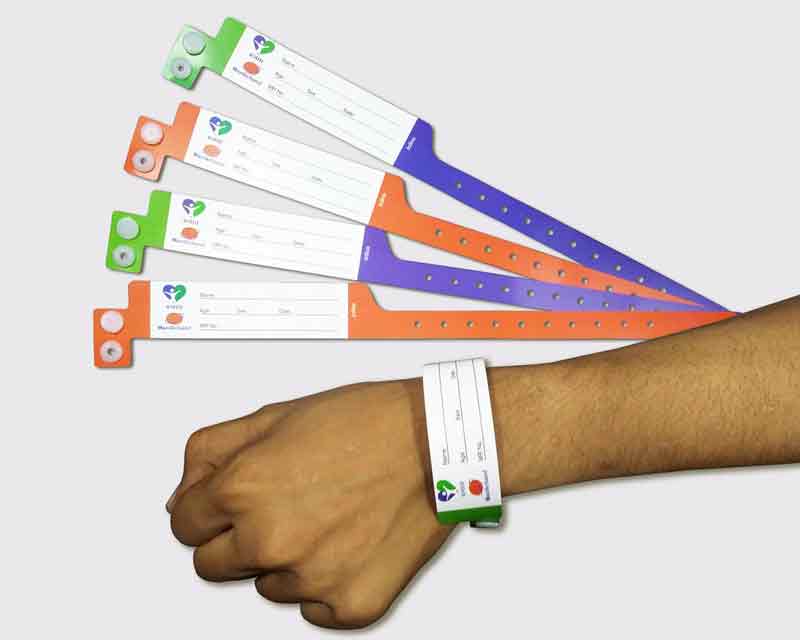A Comprehensive Guide to the Different Types of Patient Identification Band
A Comprehensive Guide to the Different Types of Patient Identification Band
Blog Article
Checking Out the Different Kinds of Patient Identification Band Used in Medical Facilities
In the intricate world of health care, the crucial role of Patient Identification bands usually goes unnoticed. These bands, differing from basic paper wristbands to innovative RFID bands, form the backbone of Patient safety procedures, making certain accuracy in Patient Identification.
Understanding the Significance of Patient Identification Bands
While they may seem like plain accessories, Patient Identification bands play a vital duty in medical facilities. These bands offer as a crucial device for confirming Patient identification, avoiding medical mistakes related to misidentification. Patient Identification bands likewise aid in simplifying administrative jobs, guaranteeing exact record-keeping and billing.
Conventional Paper Wristbands: Their Use and Limitations
Typical paper wristbands have actually been a staple in Patient Identification throughout numerous clinical facilities. While their use is prevalent, they nurture specific restrictions that might influence their efficiency in Patient administration. This area will certainly concentrate on the extent of their application and the intrinsic downsides connected with their use.
Paper Wristbands: Usage Extent
In the realm of Patient Identification, paper wristbands have actually long held a crucial role. These bands are normally used in outpatient settings, where the Patient's keep is short-lived. The wristbands consist of crucial details such as the Patient's name, day of birth, and an one-of-a-kind Identification number. This straightforward, yet effective system, permits physician to promptly and accurately recognize clients, making sure the correct therapy is provided. Paper wristbands are also used in emergency scenarios, where rapid Identification is extremely important. Their use reaches events like blood donation drives and mass vaccination programs, better highlighting their flexibility. In spite of improvements in technology, the simple paper wristband remains a dependable and cost-efficient service for Patient Identification in various health care circumstances.
Limitations of Paper Wristbands
Regardless of their extensive usage, paper wristbands are not without their downsides. In addition, paper wristbands frequently do not have the technical abilities of even more modern options, such as barcoding or RFID chips, restricting their functionality to simply displaying written details. Paper wristbands can trigger pain or skin irritability to some individuals, specifically when used for prolonged durations.
Barcoded Wristbands: Improvements in Patient Identification
While Patient Identification has actually long been a vital facet of health care, the development of barcoded wristbands signifies a considerable leap ahead. These bands utilize the simpleness of barcoding technology, permitting for Patient info to be rapidly scanned and accessed. They enhance the rate and precision of Patient Identification, decreasing the risk of medical mistakes associated to misidentification.
Superhigh Frequency Identification (RFID) Bands: a Step In The Direction Of Futuristic Health Care
The evolution of Patient Identification bands has actually caused the development of Radio Frequency Identification (RFID) Bands (patient identification band). These cutting-edge tools existing vital benefits for medical care facilities, providing an extra reliable and highly progressed methods of Patient Identification. The implementation of RFID in medical care is a significant action in the direction of an extra futuristic technique to Patient management and safety and security
Comprehending RFID Bands

RFID Bands: Key Advantages
Embracing a future where modern technology and health care merge, superhigh frequency Identification bands offer a number of crucial advantages. Mainly, these bands enhance Patient safety by offering precise, instantaneous Identification, thus decreasing clinical errors. RFID bands can store a substantial quantity of Patient data, including case history and allergies, making it possible for customized care. They additionally streamline administrative tasks, as the automated information access replaces hands-on processes, boosting performance and lowering paperwork. Additionally, RFID bands use real-time tracking of patients, important in high-risk environments such as surgical procedure or intensive care. Last but not least, these bands are immune and long lasting to environmental factors, ensuring consistent functionality. On the whole, RFID bands represent a substantial innovation in Patient Identification innovation, profiting both patients and doctor.
Executing RFID in Medical Care
These bands supply a seamless way to track and identify clients, ensuring their security and boosting effectiveness in therapy procedures. RFID bands reduce medical mistakes by offering accurate Patient Identification, which is important in avoiding misdiagnosis or incorrect medication management. Thus, the execution of RFID bands is a significant action towards enhancing Patient security and medical care shipment.

Color-Coded Wristbands: Helping in Quick and Accurate Diagnosis
In the bustling setting of a medical facility, color-coded wristbands have actually emerged as important devices for swift and accurate Identification of a person's medical problem. These wristbands, put on by clients, bring specific shades that match to different medical problems or statuses. This system is created to supply instant visual cues to medical care suppliers, enhancing Patient safety and security and care top quality.
Strategies for Efficient Implementation and Management of Patient ID Bands
Achieving optimal use Patient Identification bands demands a well-structured strategy for their implementation and administration. The primary step entails training all wellness personnel on the importance of correctly applying and checking out these bands. Medical facilities ought to standardize the use of ID bands across all departments, ensuring harmony and lowering disparities. click for info Normal audits needs to be performed to verify adherence to policies and to correct any type of disparities. Patient education and learning is additionally crucial; people have to recognize the function of the bands and the requirement for their constant wear. patient identification band. Lastly, it's necessary to have a back-up strategy in position, such as barcode scanning or biometrics, to ensure that Patient Identification is never endangered.
Verdict
Patient Identification bands are crucial in clinical centers to ensure security and precision. Reliable implementation and management of these bands can substantially lower medical errors, increase effectiveness, and boost total Patient care.
These bands, varying from basic paper wristbands to innovative RFID bands, create the foundation of Patient safety protocols, guaranteeing precision in Patient Identification.The development of Patient Identification bands has actually brought concerning the appearance of Radio Regularity Identification (RFID) Bands. On the whole, RFID bands stand for a significant improvement in Patient Identification technology, benefiting both clients and health care carriers.
RFID bands lower clinical mistakes by giving exact Patient Identification, informative post which is vital in protecting against misdiagnosis or wrong medication management. Patient education and learning is view it likewise vital; individuals need to comprehend the function of the bands and the requirement for their constant wear.
Report this page